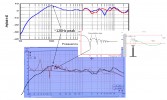MAB
Major Contributor
The speaker was reviewed at Stereophile by Kal Rubinson, with measurements!
I think you roughly reproduce the same result in your room (I stretched the Stereophile graph to roughly match your graph, and superimposed my best dotted-line-drawing of the Stereophile on-axis measurement on top):

You do have room modes, and combing too, those are placement and treatment, you can move the speakers around, but like you said there are limitations... The speakers do have a midbass bump, which can be flattened with EQ. The speakers do have the characteristic B&W voicing in the midrange, partially caused by the tweeter with no baffle and by the shallow crossover slope. Lots of people with lots of rooms like the sound but I wonder if the midrange dip is going to slightly affect your perception of the bass as you describe it. Combined with the broad peak at at 120Hz, that may be where the problem lies for you.
The 120 Hz peak should be EQ'able, hardware or software. I am not sure if placement will get rid of it. The midrange dip is also due to the speaker but is more subtle and involves tradeoffs if you want to flatten it. I would try to EQ that bass hump, see if the midrange dip is tolerable.
You do have room modes, and combing too, those are placement and treatment, you can move the speakers around, but like you said there are limitations... The speakers do have a midbass bump, which can be flattened with EQ. The speakers do have the characteristic B&W voicing in the midrange, partially caused by the tweeter with no baffle and by the shallow crossover slope. Lots of people with lots of rooms like the sound but I wonder if the midrange dip is going to slightly affect your perception of the bass as you describe it. Combined with the broad peak at at 120Hz, that may be where the problem lies for you.
The 120 Hz peak should be EQ'able, hardware or software. I am not sure if placement will get rid of it. The midrange dip is also due to the speaker but is more subtle and involves tradeoffs if you want to flatten it. I would try to EQ that bass hump, see if the midrange dip is tolerable.
Attachments
Last edited:



